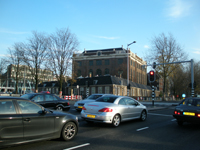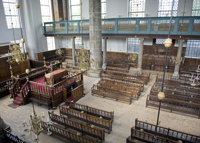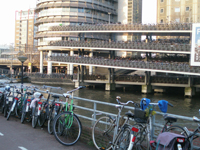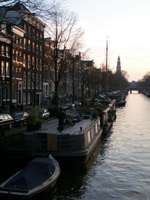By Ulla Hadar
 AMSTERDAM -—Going from Israel to Denmark at least twice a year for a family visit, the most used air route for me is via Amsterdam. There has not been any regular flight between Israel and Denmark for quite some years now. This leaves me with a lot of “lay over” time at the airport.
AMSTERDAM -—Going from Israel to Denmark at least twice a year for a family visit, the most used air route for me is via Amsterdam. There has not been any regular flight between Israel and Denmark for quite some years now. This leaves me with a lot of “lay over” time at the airport.
Returning from Denmark a couple of days ago after a visit to my mother who celebrated her 80th birthday I was accompanied by my elder sister Shani, who also lives in Israel.
Returning we had to wait in Schipol airport in Amsterdam for approximately nine hours so my sister was quick to figure out we had time for a visit to the center of Amsterdam.
Although I have had many hours of waiting in this specific airport, I have never been bold enough to leave the airport before my connecting flight. I always feared that something would go wrong and I would miss the plane. This time not being on my own, I grabbed the chance for a new experience.
The ride from Schipol to Amsterdam Central station takes only 15-20 minutes. The trains leave every 10 minutes and a round trip costs approximately eleven dollars.
The weather was beautiful. A blue sky with sunshine was reflected with the magnificent buildings in the waters of the many canals gliding gracefully among typical Dutch houses.
 Our plan was to visit the Portuguese Synagogue situated near Waterloo Square. We found the doors locked, but hoped someone still might be inside following Shabbat morning services. Banging on the door and talking loudly Hebrew didn’t help us a lot, so we had to give up entered and settled with an outside view.
Our plan was to visit the Portuguese Synagogue situated near Waterloo Square. We found the doors locked, but hoped someone still might be inside following Shabbat morning services. Banging on the door and talking loudly Hebrew didn’t help us a lot, so we had to give up entered and settled with an outside view.
Sephardic Jews fleeing Spain and Portugal during the persecutions of the 16th and early 17th centuries settled in an eastern Amsterdam neighborhood that became known as the Jewish Quarter. In light of the ongoing conflict between the Dutch Republic and Spain, the community referred to themselves as “Portuguese Jews.”
In the early 17th century, there were three Sephardic communities in Amsterdam: Beth Jacob (founded as early as 1602); Neve Shalom (1608-12); and Beth Israel (1618). In 1639, the three communities merged to form Talmud Torah, or the Portuguese Jewish Community of Amsterdam, which still exists today.
The history of the elegant brick structure containing the synagogue goes back to 1665, when it was commissioned. It was built between 1671-75. When completed, the Portuguese Synagogue was the largest synagogue in the world.
Miraculously, the synagogue survived the Nazi invasion in 1940 unscathed. It is still not known why it was left intact when virtually all other synagogues were destroyed.
Before the Nazis occupied Holland, 120,000 Jews lived in Amsterdam, around 2,300 of which were Sephardic Jews. After the war, only 20,000 Jews were left in all of the Netherlands, including just 800 Sephardim.
Today, there are nearly 20,000 Jews living in Amsterdam and the Portuguese Jewish Community has around 600 contributing members.
 Courtesy of my brother-in-law Ross Culiner, I obtained one of his private shots taken inside of the synagogue. Hopefully I will get a chance next time In Amsterdam to see all this for myself.
Courtesy of my brother-in-law Ross Culiner, I obtained one of his private shots taken inside of the synagogue. Hopefully I will get a chance next time In Amsterdam to see all this for myself.
Leaving the Waterloo Square, Shani and I strolled leisurely through the huge crowd of Saturday walkers towards the flower market.
When we arrived there we could enjoy the colors of the different plants on exhibit. Passing through the small stalls filled with plants, flowers, we could choose from all kinds of small souvenirs. One stall even offered a 3-Euro starter set to grow cannabis!!!
 Reaching the central station I was amazed to discover the parking lot next to the entrance. Instead of the usual parking garage for cars, here there is a four-story garage for bicycles. It is quite impressive. I could not start musing on how the bikes in Amsterdam look compared to the bikes in Israel. The bikes in Amsterdam looks like the ones I was used to in Denmark when growing up. Plain bikes with no gears, with a dynamo and a simple lock. Many of the bicycles have children seats in the front or in the back. I did not spot one single sport bike with gears during my hours in Amsterdam.
Reaching the central station I was amazed to discover the parking lot next to the entrance. Instead of the usual parking garage for cars, here there is a four-story garage for bicycles. It is quite impressive. I could not start musing on how the bikes in Amsterdam look compared to the bikes in Israel. The bikes in Amsterdam looks like the ones I was used to in Denmark when growing up. Plain bikes with no gears, with a dynamo and a simple lock. Many of the bicycles have children seats in the front or in the back. I did not spot one single sport bike with gears during my hours in Amsterdam.
In Israel, the biking trend has been growing at the speed of an erupting volcano in the last five years. But in Israel the norm is that you can not start biking without buying at least a 24-gear sports bike with everything that comes with it (gloves, shoes, clothing etc.). This fact has always amused me, having grown up in another reality.
One fact that bothered me watching the many grown ups and children passing on the streets of Amsterdam was that no one wears a helmet. An accident can happen so easily and a child thrown off a bike or a grown up tripping over is helpless without any protection. I personally have experienced that the helmet protected me against serious injuries several times. In Israel and also in Denmark it is law to wear a helmet.
 The two of us continued our stroll with a quick visit to a local fish and vegetable market leading us through small streets with typical Dutch architectural houses surrounding us.
The two of us continued our stroll with a quick visit to a local fish and vegetable market leading us through small streets with typical Dutch architectural houses surrounding us.
Each corner in these neigborhoods has coffee houses well-frequented by local citizens.
As dusk started to cover us, we strolled back to the train station for the return trip to the airport. My conclusion, the next time I have some hours to wait in Schipol airport I am definitely going for another stroll in this enchanting and beautiful city.
*
Hadar is bureau chief in Sha’ar Hanegev, Israel, for San Diego Jewish World